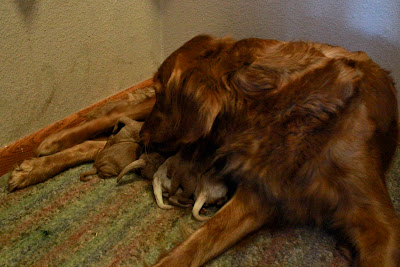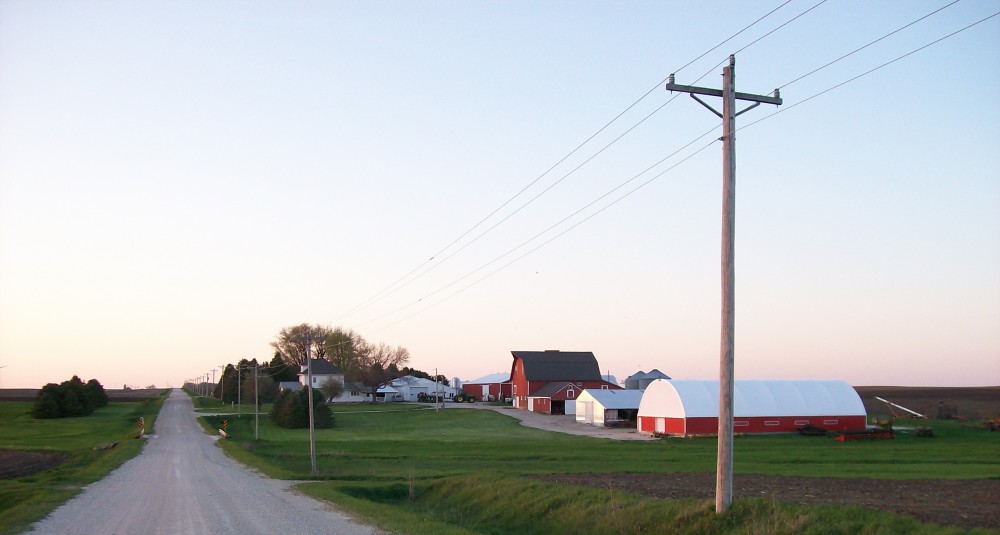Katie Jo wrote recently about life and death on the farm – I would like to take this opportunity to inform everyone about just the life side, as we witnessed Sunday night.
 The Friests’ trusted 4-year-old Golden Retriever, Paige, had 10 Golden Doodle puppies! She had obviously been very pregnant since we met her, and she was scheduled to have the pups before we concluded our time here; so, of course, we had to see them. The Friests called us just as we were finishing dinner on Sunday to report the good news, so we drove down to see all 10 of the adorable puppies (3 girls and 7 boys, if I remember correctly) and their calm, poised, tired mama.
The Friests’ trusted 4-year-old Golden Retriever, Paige, had 10 Golden Doodle puppies! She had obviously been very pregnant since we met her, and she was scheduled to have the pups before we concluded our time here; so, of course, we had to see them. The Friests called us just as we were finishing dinner on Sunday to report the good news, so we drove down to see all 10 of the adorable puppies (3 girls and 7 boys, if I remember correctly) and their calm, poised, tired mama.
Paige is so small; I don’t even understand how 10 living creatures came out of her! She was so patient with all of her pups, licking and moving them to make sure that they all got food, warmth, and equal love. She had one similar litter two years ago, and her instinctual skills are apparently unforgettable.
 Speaking of instinct – why is it that dogs have such large litters compared to humans? Are they in danger of extinction? Unless I’m grossly under-informed, there’s not a high risk of puppy death. And why do puppies become self-sufficient in a matter of weeks, while humans can take 18 years or more?
Speaking of instinct – why is it that dogs have such large litters compared to humans? Are they in danger of extinction? Unless I’m grossly under-informed, there’s not a high risk of puppy death. And why do puppies become self-sufficient in a matter of weeks, while humans can take 18 years or more?
For those of you who don’t know, in the past 3 weeks, I’ve graduated, celebrated my 22nd birthday, and been provisionally hired for a real, live teaching position in Texas. I don’t really feel any older; perhaps because of the quickness of it all, I am just trying to take things as they come, one day at a time. It’s finally beginning to hit that I am moving out of my parents’ house – for real this time, and not just to take a multi-state journey to Furman’s campus that will eventually lead me home again. I feel no more independent now than I did when I left for college, but when I begin to think about it, I’ve learned a lot over the last four weeks – academically, socially, you name it.
Puppies don’t go to college. (But they do go to pre-school…at least, my puppy did, when I was seven or eight. She was trained how to heel, stay, lie down, etc. before her symbolic graduation.) And yet, they instinctually know how to survive – and not only survive, but thrive, bringing 8-12 offspring into the world each breeding! I’ve always been amazed by dog instincts, as I grew up being very close to my two Goldens in succession – their ability to sleep with one eye open (or one of two eyelid layers open, rather); their keen smell; their uncanny sense of the master’s mood; their yearning to be in a pack, in a safe and secure area, or just around their “people” – do humans have these instincts? We are completely helpless for at least a few months, needing our parents or other caretakers not only to feed us but to transport us and teach us everything we will know. Our parents can’t even really understand us – do dog moms understand puppy whines? I digress. How do animals get away with existing as “mini-adults” so soon, while humans need to be catered to? Who’s getting the better deal, anyway?

